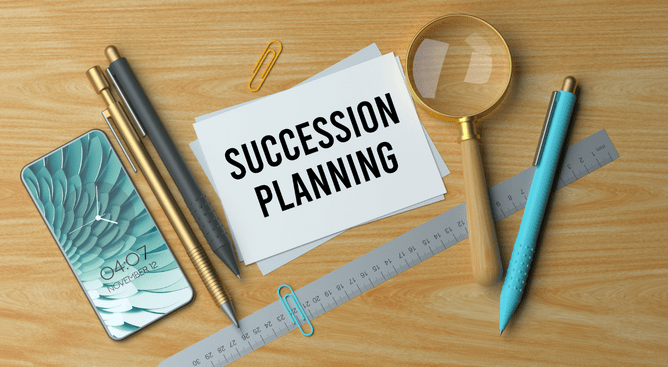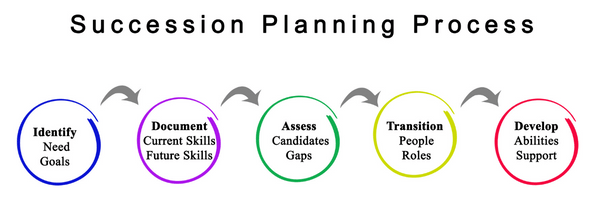In these challenging times it’s absolutely key that businesses hold onto their top talent and retain knowledge and expertise. One strategy which can be put in place is Succession Planning. Having recognised that the delegation of tasks, transfer of knowledge and responsibilities and understanding of business systems and processes, is critical to sustainability, a clear Succession Plan will contribute to the ongoing success of your organisation.
Not only that, but succession planning is a relatively low cost to the business and with a plan in place, ensures a degree of stability even whilst key roles and personnel are evolving.
Succession planning is about identifying your peoples’ potential
Succession planning is focused on targeting employees with the right skills and potential in order to develop their attributes and knowledge thus responsibilities can be transferred with the minimum of impact.
Organisational change is a given - how companies manage that change can be a major differentiator between the successful and the not so successful. With so much negativity in the air right now (we’re reading about the ‘Great Resignation’ and ‘Quiet Quitting’ on a regular basis) let’s focus on a practical and proactive strategy for retaining your creative, dynamic and knowledgeable people whilst reducing costs at the same time.
How do I put together a Succession Plan?
To ensure your Succession Plan has all the elements needed for success, the following tasks should be included:
- List the main roles to be covering in the plan
- Which skills could we lose in the near future?
- Create job profiles, identifying tasks undertaken and skills/knowledge required
- Review recruitment strategies (including upskilling of current employees)
- Appoint the candidate who’s best fit
- Invest in the handover process
- Record the transition to aid future strategies
Whose responsibility is it to put a Succession strategy in place?
Typically, the HR function will be responsible for succession planning given that it goes hand in hand with workforce planning. The likely impact of vacant roles and what’s required to fill them should also be part of any learning and development plan so the right training and career support is available to your workforce.
Best practice would suggest succession plans are revisited on an annual basis to ensure they are still relevant to your organisation’s evolution.
So let’s look at the key elements in more detail.
A Succession Plan should include a list of the main roles
Identify the key roles that, should one become vacant, pose the most impact (and threat) to the business. Which areas or departments hold the most intel? Which individual is the ‘font of all knowledge’? Which qualifications are deemed the most critical?
Take the time to evaluate the potential weak links in the chain should the organisation be faced with a departure. In smaller companies this evaluation is vital since one individual may ‘own’ a particular business area. Is there one person who manages the top client relationships? Does one technician hold all the IT knowledge?
Identifying (and most importantly, documenting) the main roles within the organisation will naturally identify the desirable qualifications which will need to be replaced.
Which skills could we lose in the near future?
Now take some time to look at your workforce and, albeit without a crystal ball, assess who you are likely to lose in the near future. This will include potential retirees and a guestimate based on your current staff turnover. It’s also a good idea to look at your current management structure and from the CEO through to departmental leaders, evaluate the skills and qualifications which reside with those individuals.
Build into this task an allocation of time and an estimate of costs in order to assess the impact of change. Include notice periods, the duration of any selection process and document the ideal length of a handover (we’ll look at this element in more detail later).
Create job profiles, identifying tasks undertaken and skills/knowledge required
This sounds pretty straightforward, especially if your HR function already has some generic job profiles in situ. For a job profile to be effective it should include:
- A list of key tasks each role currently undertakes
- A list of qualifications held by the individual currently in the role
- An assessment of how the role may evolve over time
- Identify additional skills that may be desirable in the future
Keep in mind that the job profile should be meaningful now but also creates scope for development in the future. It also means that your planning strategy isn’t tied to one person with (currently) a very specific skill set.
Review recruitment strategies (including upskilling of current employees)
Businesses can come at this from a number of angles and importantly, it doesn’t revolve around external recruitment processes. For example, do you have an employee referral system? Does HR manage a talent pool for retaining unsuccessful applicants or for individuals who express an interest to join the company? Do you offer opportunities for job development and upskilling? There’s a lot of debate at the moment about upskilling; investing in your current workforce and identifying potential is an effective policy for staff retention.
These proactive measures may enable the business to recruit effectively from within the organisation with all the benefits of knowledge transfer and an established work culture fit between employee and organisation.
Appoint the candidate who’s the best fit
So how do you assess the likelihood of a good fit with the company’s culture? What measures beyond the basic interview can the organisation draw on in order to find the right candidate?
With the culture fit being a real and tangible indicator of success, you may also want to consider seeking feedback from potential work colleagues. Organising a second interview or work-based task, an informal lunch meeting perhaps - the goal being to enable additional feedback to be gathered. These settings give the opportunity for other key personnel to voice opinions and express their thoughts on the suitability of the job applicant.
The ability to deliver tasks according to the job profile is just one element in the evaluation of a candidate.
Invest in the handover process
In an ideal world, the length of the handover process would run into several months, however, this is sometimes impractical due to budgets, time and other constraints. Ideally there should be some time with the outgoing personnel and a time investment from co-workers and line managers.
Handover duration will depend on the role being transferred - the more complex and wide-ranging the tasks, the more time required in order for the transfer of knowledge to be effective. Also bear in mind that a handover which is too long in duration may be counter-effective. Incoming candidates will, naturally, want to stamp their own authority on the role and the company is in danger of thwarting creativity and innovation if the handover is too onerous.
Focus less on the information which is readily accessible (for example via an internal portal) and spend more time on handing over the intricacies and nuances of the role.
Record the transition to aid future strategies
This is key and will help businesses fine-tune the recruitment and succession planning strategies going forward. Document the steps undertaken during the transition process and include the following observations:
- Issues which arose specifically around a particular role/vacancy
- Identify which aspects of the handover went smoothly and those which caused confusion
- Identify potential knowledge gaps
Learn more about what a great Success Plan looks like
In this blog, we’ve identified what a Succession Plan is and why it’s good for business. We’ve also looked at what needs to be included in the plan and importantly, to record how well the plan was implemented in order to fine-tune succession planning going forward.
In our next blog in the series, 'What does an effective Succession Plan look like?' we’ll preempt any likely hurdles to establishing a Succession Plan strategy and once those have been overcome, what a great (and effective) plan might look like.
How can Q&A People Matter help you?
Do you need advice setting up your organisation's Succession Plan or advice concerning other HR-related matters?
Contact us - we're here to help you.










